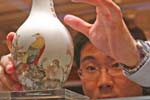Op-Ed Contributors
Debate: Urban congestion
Updated: 2011-04-12 08:00
(China Daily)
Su Yang
Multiple centers can clear jams
At the two sessions of the Beijing municipal people's congress and the Chinese people's political consultative conference Beijing committee in early 2011, traffic jams and rising population in the capital were a big concern of the delegates and members.
According to the Beijing Overall Urban Plan (2004-2020), approved by the State Council in 2005, the city's population should not have exceeded 18 million before 2020. But statistics show that by the end of last year the city's population had not only crossed that figure, but had reached 19.72 million. Thankfully, overpopulation has not strained the city until now.
It is believed that only economic factors, which influence employment, determine the city's population bearing capacity and resources and the environment are only peripheral elements.
Beijing indeed is overcrowded, but that should not reduce the quality of people's lives. The crux of the city's problems is not the population explosion, but its improper development model and blind urban planning. The capital has not implemented a proper urban development plan effectively. This is a common problem that plagues the other mega-cities, too.
The population bearing capacity of a city is determined by its region's economic size and interstitial structure. A more efficient way of regulating the size of regional population is to control it by industrial structure. By adjusting the industrial and employment structures, city planners can control regional population and promote equality in basic public services.
But city planners must also shift from concentric-circle to cluster-based development, building multiple centers in a city.
If they combine such measures with adequate public transport and strict traffic restrictions in certain areas, they will reduce the flow of a lot of unnecessary traffic and congestion in the city's administrative and financial center.
Of course, implementing such a plan in Beijing is wrought with difficulties. Vested interests will oppose the adjustments in government agencies, and education and healthcare resources.
But the majority of commuters who flock to the city center every morning and rush out from there every evening in overcrowded public buses and trains personally feel the pressure created by the present development model of concentric circles and the over-concentration of quality education and healthcare resources in certain places. Such people will certainly favor moving Beijing's quality public services beyond the Second Ring Road.
In fact, many Chinese cities (including provincial capitals) have already started planning to develop multiple centers and adjust the layout of quality education and healthcare resources. The basic requirement is to relocate government agencies, including good schools and hospitals, out of the "old city" to the new centers. If this is done, the new centers will get enough development momentum to grow into independent mini-cities within a large city.
But whether the overcrowded cities can develop more healthily depends on whether local decision-makers are ready to prioritize the basic interests of the majority of the city's population.
If we succeed in controlling the size of a city's population by adjusting its industrial structure through cluster-based development, traffic congestion in mega-cities will ease greatly.
The author is a research scholar with the Development Research Center of the State Council.
Specials

Share your China stories!
Foreign readers are invited to share your China stories.

Art auctions
China accounted for 33% of global fine art sales.

Waiting for drivers' seat
Lack of sponsorship appears to be why Chinese drivers have yet to race in a Formula 1 event